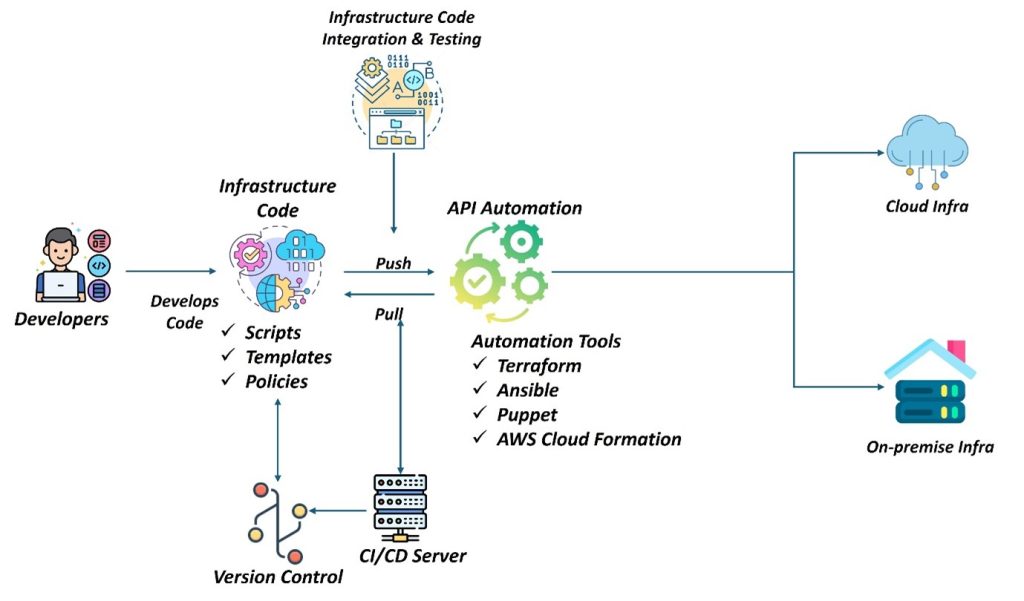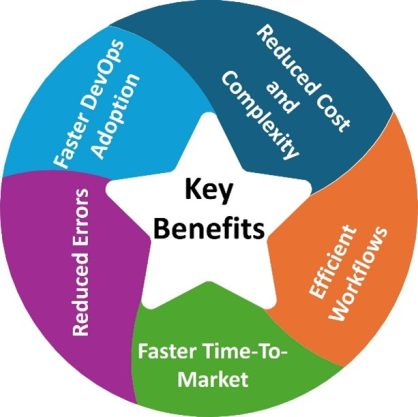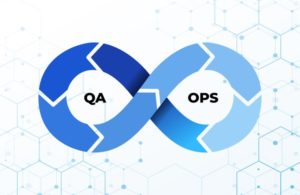Enterprises in the digital era are focused on increasing operational efficiency while reducing IT costs. From application releases to customer support, every single aspect related to IT demands rapid solutions that lead to reduction in manual work and deliver an enhanced experience. Today, a large number of organizations are looking for agile and flexible methods and technology solutions to gain a competitive advantage in the market. Well, this is exactly where IT infrastructure automation comes into play.
It would not be wrong to say, that in a digital world, bringing high-quality products into the market as quickly as possible has displaced all other business priorities. Organizations that successfully accelerate their product development processes stay ahead of the curve.
Yet, it takes days (or even weeks) from the time a request is made to when the service is fully deployed – leading to an ever-increasing backlog of infrastructure-related requests. And response and turnaround times take a beating.
Improving IT speed and agility, while reducing complexity, is a difficult undertaking. The right team, right tools, and right infrastructure are required to attain this improvement.
So, the million-dollar question is how do teams accelerate the process? The answer is by embracing the world of infrastructure automation. Let us explore what is infrastructure automation and how it benefits the IT industry.
What is Infrastructure Automation and Why Adopt it?
Before we jump into the concept of infrastructure automation, it is important to explore and understand the basic terminologies related to the same as listed below:
- Infrastructure: The IT ecosystem constituting of both, hardware and software elements is known as infrastructure. For instance, the servers, storage, networking, and computing devices.
- Provisioning: The term indicates the process of making the infrastructure available to end users.
- Configuration: The setting up of the infrastructure which includes connecting and setting up database and network.
- Automation: The infrastructure tasks such as setting up of network devices, users, and software installations will be automated.
- Orchestration: The process of managing several automation tasks to streamline the overall workflow.
In IT infrastructure automation, the terms “Infrastructure as a Code (IaaC) or Infrastructure as Code (IaC)” as well as “Continuous Integration/Continuous Deployment (CI/CD)” are the two key approaches embraced by enterprises to deliver infrastructure and applications faster and securely.
The use of software or code to set up and configure the infrastructure of the process is known as IaC. CI/CD is utilized to modernize and speed up the software development lifecycle process. Continuous Integration is the process of integrating the code changes automatically into a shared repository. This helps identify any issues at the earlier stage of the development process. Continuous Development or Delivery process automates the delivery of entire code to environments such as testing and development.

The developer team writes the code with the appropriate programming language. The infrastructure code defines the infrastructure in a text file and has the benefit of version control. This enables us to see the changes made in the code and at what time they have been modified. The code files are transferred to a code repository. With the help of IaC tools, the code runs and performs the essential functions, realizing automated infrastructure provisioning and deployment. The CI/CD integration with IaC facilitates continuous and automated deployments.
Now, let us deep dive into what is infrastructure automation and how it benefits the organization to meet the dynamic market trends!
Infrastructure automation is transforming the product development landscape
Managing and provisioning workloads – on-premises or in a cloud environment – takes up a lot of precious development time, especially when done manually. An ad-hoc, reactive approach to infrastructure provisioning has, unfortunately, become the norm. However, the impact of such an approach on product development is extremely far-reaching. Teams get overrun with requests, the chances of error are high, and time-to-market is often delayed.
The result? Poor customer satisfaction, competitive position, and brand reputation. The solution? Infrastructure automation!
The infrastructure automation process simplifies human interaction with IT systems by building functions that can be utilized by other software and by automating repetitive tasks.
Infrastructure automation is rapidly transforming the product development landscape. Automating the process of server provisioning, configuration management, and code deployments is enabling teams to achieve faster application delivery while eliminating human error and paving the way for greater consistency. Using practices such as IaC, infrastructure automation can help teams deploy new applications or update dependencies at a faster rate. Since it automatically carries out repetitive and routine tasks, manual efforts are minimized, allowing teams to adapt to diverse on-premises or cloud-based infrastructures.
Infrastructure automation also brings in a great degree of uniformity in infrastructure deployments while helping orchestrate changes across environments—quickly and effectively—allowing developers to drive all their focus on developing quality and feature-rich software.
Benefits of Infrastructure Automation are manifold.
Automated provisioning of infrastructure can have a huge impact on the bottom line. Since all manual steps and interventions are eliminated, teams can achieve immutable releases with zero downtime. Here are some key benefits of infrastructure automation:

Reduced complexity and costs: Believe it or not, one of the most undeniable benefits of infrastructure automation is reduction in the complexity of provisioning (and managing) IT infrastructure. Unlike traditional approaches that needed significant investment by teams—both in terms of cost and effort—to plan, customize, implement, and maintain IT infrastructure, infrastructure automation is a cost-effective solution to managing the complexity which comes with infrastructure provisioning. Not only does it reduce the administrative burden, but it also helps IT teams provide immediate value.
Infrastructure automation on the other hand eliminates the need for large teams to perform a range of manual steps to get started with product development. Hence, it can help save on staffing costs. For organizations that have large teams and complex infrastructures, the savings could be extensive and the improvement in quality substantial.
Faster DevOps Adoption: this is one of the best practices that foster the integration of software development (Dev) and Information Technology (IT) operations (Ops). Automation is the core element of DevOps. Infrastructure as a Code (IaC) helps DevOps teams to automate the infrastructure eliminating the need of manual procedures. This practice helps enterprises to achieve agility and scalability, lowering the intricacies of infrastructure management.
More efficient workflows: Through automation of a variety of IT provisioning tasks with great efficiency and accuracy, infrastructure automation lays the foundation for more efficient workflows. Teams can set the conditions to provision infrastructure and ensure they are executed only when the right condition is met. Since each task within a workflow can have separate dependencies, teams can have more control over how servers or other infrastructure get provisioned.
Faster delivery: Because infrastructure automation automates the process of IT provisioning, it also greatly reduces the time (and effort) needed to set up the underlying infrastructure. Teams can get started with building products sooner and bring them to the market faster—thus outpacing the competition and meeting the customer demands effectively.
Reduced error: Infrastructure automation also greatly reduces the error rate associated with manual provisioning of servers. Since all the necessary infrastructure gets provisioned automatically, without any human intervention, it reduces the chances (and impact) of error while empowering IT teams to focus on tasks that are mission-critical for the organization.
Improve time-to-market: Infrastructure automation solutions supports the streamlining of new software releases or the software development lifecycle, helping to meet the growing market demands. For every enterprise to provide better customer experience and to stay competitive in the market automation is necessary.
Wrapping Up
When it comes to driving value at a faster rate, automating repetitive tasks is a great way for IT teams to step up and focus on things that really matter. In the world of product development, IT infrastructure automation holds great promise. By automating the process of provisioning and maintaining complex servers and other critical IT infrastructure, infrastructure automation has the potential to transform nearly every aspect of on-premises and cloud environments. As part of Calsoft’s Automation & Integration expertise, we help our customers analyze existing systems and find gaps that can be addressed by automation and integration. Embrace infrastructure automation today to make IT deployments far more efficient, reduce errors, and improve time-to-market.
Looking for automated infrastructure deployments and better orchestration?






